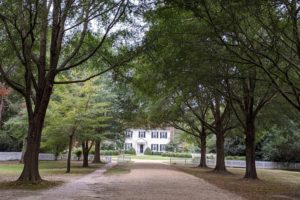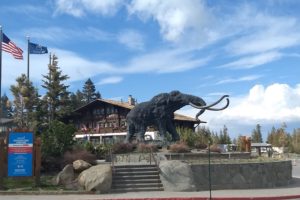A few miles east of the South Unit’s visitors center and the town of Medora is a 3rd visitors center for the park: Painted Canyon. This area is on the upper range of the Badlands and provides an amazing panorama of the broken land. While we were in Medora, we were able to watch the SD buffalo roundup at Custer State park online that we’ll show you at the end of this post. Some year we’d like to see it in person.

What is the Badlands? Is it 1 word or 2? Should it be capitalized? We’ll discover more when we visit South Dakota on another trip, but I remember one definition from a local tribe: it’s a place so “bad” that no one can live there. We just see it as beautiful. All around this smaller visitors center with its views of the Badlands were these informational signs.
soldiers and the Sioux

Treaties between the U.S. government and the tribes were made and broken; tensions rose as more Euro-Americans moved west. To protect their homeland, tribes defended their homes and cultures any way they could.

Herds of cattle came with the expeditions to provide food in case their hunters weren’t able to provide enough meat. In narrow valleys, the column might be strung out for 3-4 miles. No wonder traces of their passing can still be seen today.
Santee Sioux
For the Santee Sioux, tensions peaked in August 1862 when their uprising in Minnesota Territory left 450-800 settlers and soldiers dead. Brig. Gen. Henry Sibley took 1400 solders with him to suppress the uprising. Many Santee were captured, while others fled west to join other Sioux bands. Sibley and Brig, Gen. Alfred Sully pursued the Santee into Dakota Territory where Sibley fought several battles in July and August 1863. In September, Sully’s attack on a Sioux village at Whitestone Hill in ND resulted in more Indian deaths than any other conflict on the Northern Plains.
We’ve already learned about Sully’s campaign in the 1864 Battle of the Badlands at Killdeer Mountain that eventually ended with the Sioux in retreat.
The “Sioux” can refer to several bands that fought together during the Great Sioux war. At times they were joined by a few Northern Cheyenne and members of other tribes.

protecting survey crews
By the late 1860s, the railroad was pushing west from Bismarck. The Sioux were determined to stop them after seeing the decimation of bison herds that came with the rail lines.
Three survey parties, escorted by large military detachments crossed the Dakota badlands.

Ignoring an 1868 treaty, the U.S. government tried to get the Lakota Sioux to cede the Black Hills (South Dakota) to gold seekers who were pouring into the area. The Sioux didn’t want to give up their land, so Brig, Gen. Alfred Terry and Lt. Col. George Custer headed west to enforce the edict in 1876.

the badlands





dude on the frontier


Roosevelt’s timeline

1866: keen interest in the natural world led this 8-year-old and his 2 cousins to start the “Roosevelt Museum of Natural History” in his bedroom (to the dismay of household help)

1880: married Alice Lee on his 22nd birthday
1881: got involved in politics and was selected to the NY State Assembly
1883: made his 1st visit to ND badlands and invested in Maltese Cross Ranch
1884: Alice died of kidney failure during childbirth; his mother had died in the same house hours earlier of typhoid fever.
He was with both women when they died and was stricken with grief.


1887: lost much of his cattle herd in ND from too little food caused by overgrazing and a harsh winter

1905: won the presidency in a landside victory; inaugurated on March 4

As President, he set aside nearly 1/10 of this country to be conserved as national lands for the benefit of us all. This National Park was established after his death to honor him as a great “Conservationist President” and the lessons he learned when living here.
the wilderness that was here



SD’s Custer State Park bison roundup
Once a year in Custer State Park, the buffalo are rounded up to be moved to the southern part of the park for the winter. We met a couple on this trip who managed to snag reservations to see this roundup in person. We watched it online.








The next post will take us into the park for some up-close views of what Theodore Roosevelt would have seen.




